Introduction
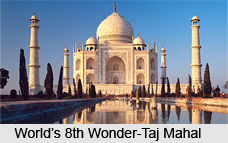 Taj Mahal is a World Heritage Monument in India which was built by Mughal Emperor Shah Jahan in memory of his wife Mumtaz. It is considered as one of the greatest architectural achievement in the whole range of Indo-Islamic architecture. It attracts millions of visitors a year. In 2007, it was declared a winner of the New7 Wonders of the World.
Taj Mahal is a World Heritage Monument in India which was built by Mughal Emperor Shah Jahan in memory of his wife Mumtaz. It is considered as one of the greatest architectural achievement in the whole range of Indo-Islamic architecture. It attracts millions of visitors a year. In 2007, it was declared a winner of the New7 Wonders of the World.
Location of Taj Mahal
Taj Mahal is located at the south bank of the Yamuna River in the Indian city of Agra. With a vast Mughal garden that covers almost 17 hectares, it is located in the Agra District in Uttar Pradesh.
History of Taj Mahal
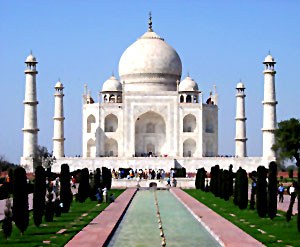 The history of Taj Mahal will definitely take one back to the Mughal eras of Akbar and his father Humayun. The Mughal invasion of India was nothing but an explosion of anger and conquest - a great demonstration of the powerful human instinct and aggressive urge to explore and conquer. With drawn swords and shrill battle cries, they came from harsh, dry, desert lands. Some of those who came and destroyed the land`s cultural heritage but some were peace-loving rulers. Akbar was one of them. His policies of religious tolerance made him popular with the masses. His son, Jahangir, was a connoisseur and patron of the arts and crafts. It was in such milieu that Prince Khurram, later known as Shah Jahan, was born.
The history of Taj Mahal will definitely take one back to the Mughal eras of Akbar and his father Humayun. The Mughal invasion of India was nothing but an explosion of anger and conquest - a great demonstration of the powerful human instinct and aggressive urge to explore and conquer. With drawn swords and shrill battle cries, they came from harsh, dry, desert lands. Some of those who came and destroyed the land`s cultural heritage but some were peace-loving rulers. Akbar was one of them. His policies of religious tolerance made him popular with the masses. His son, Jahangir, was a connoisseur and patron of the arts and crafts. It was in such milieu that Prince Khurram, later known as Shah Jahan, was born.
It was in the festive Meena Bazaar of Agra that Prince Khurram met the14-year old Arjamand Bano selling glass beads with long tresses, deep expressive eyes and a delicate aquiline nose. Undoubtedly she was beautiful. Prince Khurram fell in love with her then and there. In fact it would not be wrong to say that the young prince was magnetically drawn to her. That timeless moment moulded their future together for posterity. She held a piece of glass in her hand and told the young prince it was a rare and precious diamond. She even succeeded in selling it for an unbelievable amount.
When Prince Khurram expressed his desire to marry Arjamand Bano the very next day after he met her, Jahangir immediately consented. However, that marriage was not to happen until five years later. Meanwhile, Shah Jahan`s first marriage was arranged with Quandari Begum, a princess from the Persian royal family. Despite this his feelings towards Arjamand Bano had not changed. He loved her just as deeply and as madly as that memorable moment when they had first met.
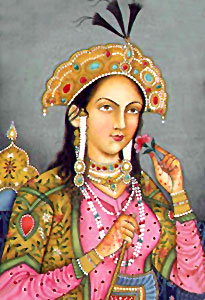 In 1612, the young prince was finally permitted to marry Arjamand Bano. She was given the name Mumtaz Mahal or `the chosen one of the palace`. In 1616 Prince Khurram who emerged victorious from the battle of Deccan, was bestowed the title of Shah Sultan Khurram. On 29th October 1627 Jehangir passed away. The 4th February of 1628, saw Shah Sultan Khurram became Shah Jahan, Emperor of the World.
In 1612, the young prince was finally permitted to marry Arjamand Bano. She was given the name Mumtaz Mahal or `the chosen one of the palace`. In 1616 Prince Khurram who emerged victorious from the battle of Deccan, was bestowed the title of Shah Sultan Khurram. On 29th October 1627 Jehangir passed away. The 4th February of 1628, saw Shah Sultan Khurram became Shah Jahan, Emperor of the World.
For 19 long years, Mumtaz Mahal had been his constant companion accompanying him everywhere; from the prayer halls to pleasure gardens to river banks and court meetings, to the coronation and finally to the battlefields. She was his playmate, companion, confidante, friend, philosopher and guide. The two shared such a deep bond of affection, attachment and understanding; that they were nearly inseparable from one another.
Mumtaz-uz-Zamani died in 1631 on the battlefields of Burhanpur. She had accompanied her husband despite his severe remonstrations not to do so. As Mumtaz Mahal lay on her deathbed she asked Shah Jahan to fulfill few promises. Amongst these one was to build a monument that would symbolize the beauty, purity and the depth of their love. That the emperor`s heart was heavy with grief is a mild way to express how her passing away so prematurely had shattered his world. The young man so fond of opulence then confined himself to a life enshrined in mere memories. Almost overnight his luxurious lifestyle underwent a complete change. Pomp and splendour now gave way to austerity. For two years the entire state observed deep mourning.
The emperor had turned `fakir` at heart. He desired nothing. His days were pale, colourless, devoid of life as it were. Dressed in white, a Spartan way of life became a habit. The pain of separation gripped him. With an iron will, perhaps a legacy of the Rajput blood flowing in his veins, he steeled himself to create an outstanding work of art.
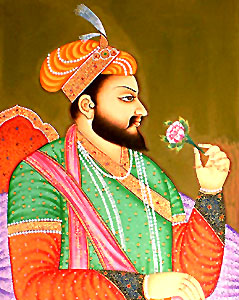 The painstaking detail with which more than 20, 000 of the world`s finest craftsmen toiled for 17 long years, (between 1632 to 1648) makes the Taj a great vision of an intense emotion captured frame-by-frame in exquisite marble. The planning team and the builders of the Taj Mahal were practitioners of a sacred science, flawless geometry and religious architecture. They comprised of a mix of Indian, Persian and Turkish experts. This monument was a form of secular art that was neither Saracenic, Central Asian nor Hindu or Islamic in expression. Rather it was divine in its purity.
The painstaking detail with which more than 20, 000 of the world`s finest craftsmen toiled for 17 long years, (between 1632 to 1648) makes the Taj a great vision of an intense emotion captured frame-by-frame in exquisite marble. The planning team and the builders of the Taj Mahal were practitioners of a sacred science, flawless geometry and religious architecture. They comprised of a mix of Indian, Persian and Turkish experts. This monument was a form of secular art that was neither Saracenic, Central Asian nor Hindu or Islamic in expression. Rather it was divine in its purity.
In the Badshahnama by Abdul Hamid Lahori the official chronicler to Emperor Shah Jahan, it is mentioned that the building was constructed at a cost of Rs. 50 lakhs. In earlier times, two silver doors stood majestically at the entrance of the Taj Mahal. They were believed to have been made at a cost of Rs 1, 27,000. Each door was studded with 1,100 nails each having a head made of a rupee coin. A feature that is common to many schools of religious architecture is symmetry and self-replicating patterns. Like a fractal pattern, the symmetry keeps appearing even in the minutest block of the monuments that adorn the Taj Mahal building complex. And thus the ethereal monument, Taj Mahal, was built.
Once the Taj Mahal is seen, it will stay on forever in one`s mind, rejuvenating the inherent romantic self. Like a weaver, forging new threads and darning old ones, the Taj Mahal remains as a beautiful tapestry in one`s memory. Doubtlessly, there`s something mesmerizing about the Taj Mahal. The monument spells out a warning. Love and romance can happen to anyone, anywhere, anytime.
Architecture of Taj Mahal
Architecture of Taj Mahal is one of the finest specimens of artistry in India. The efforts and dexterity of Indian architects during the Mughal rule had found magnificent expression through the meticulous and brilliant elements that compile to form this extraordinary structure. Located in Agra, Uttar Pradesh, it was built by the Mughal emperor Shah Jahan as a dedication to his third wife Mumtaz Mahal. Architecture of Taj Mahal exhibits a combination of Persian, Islamic, Ottoman Turkish and Indian styles. The eminent architecture of this stunning monument enlisted it among the World Heritage Sites. Taj Mahal is in fact a compilation of several structures, each having admirable beauty. The construction of this monument began in 1632 and continued up to 1653. The basic elements of construction were white marble and precious gemstones.
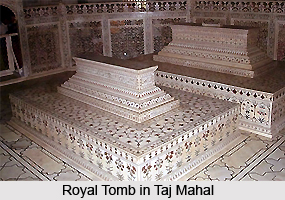 Tomb Architecture of Taj Mahal
Tomb Architecture of Taj Mahal
The central focus of this beautiful structure is the tomb made of white marble. This large tomb is housed on a square plinth and has typical Persian elements. It`s most attractive feature is the large marble dome surmounting the tomb and a finial at the top. At the four corners of the plinth, there are four minarets framing the tomb. The dome top is embellished with a lotus design. The dome is also known as onion dome because of its shape. Amalgamation of Hindu and Persian elements of decoration can be observed in the finial which was originally created by gold but was later replaced by bronze. A moon with its tips pointing towards heaven, a typical motif of Islam, tops the finial. In Muslim culture, personal sanctity can be achieved by visiting the resting place of the venerated in Islam.
Exterior Architecture of Taj Mahal
Magnificent Mughal architecture decorates the exterior of Taj Mahal. Different types of craftworks including stone inlays, stone carvings, paintings and stucco had conferred beautiful architecture to Taj Mahal. The designs and motifs on the exterior of Taj Mahal can be categorized as abstract, calligraphy and vegetative patterns. Passages from Quran can be prominently witnessed among the decorations. Calligraphy work of Taj Mahal comprises of thuluth script, inscribed on white marble panels. Abstract paintings can be found on different parts of the monument including minarets, gateways, plinth, and mosques and on the surface of the tomb. Floral and geometrical motifs are also painted on different parts of the structure.
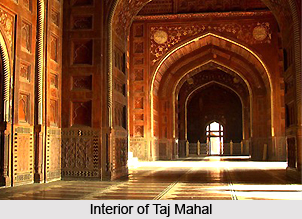 Interior Architecture of Taj Mahal
Interior Architecture of Taj Mahal
Interior architecture of Taj Mahal is a little different from the traditional style and is adorned with precious gemstones. The inner chamber has an octagonal shape with entry door at each of it faces. However, the door towards the south, which faces the garden, is only used. The chamber has a false dome with sun motifs made on them. Intricate decoration of graves is forbidden in Muslim tradition for which the dead bodies of Shah Jahan and Mumtaz were placed in simple crypts where their faces were turned towards Mecca, in their right side. The grave of Mumtaz Mahal is placed on a rectangular base of marble. Precious gemstones embellish the base and calligraphic inscriptions on the casket are made in the praise of Mumtaz. Caskets of men and women have icons of pen box and writing table, which are the icons of funerary in Mughal tradition.
Paradise Garden (Charbagh) of Taj Mahal
Paradise garden is a Persian concept brought about by Mughal, derived from Persian Timurid gardens. The garden beholds many symbolisms. Paradise garden, also known as charbagh is a square garden which is equally divided into four equal parts. The four parts of the garden are further divided into sixteen flowerbeds with the help of raised pathways. There is a central water tank made of marble that reflects the mausoleum. Trees and fountains decorate the garden in the most artistic manner. As per traditional Islamic texts, a paradise is a garden with an abundance of flowers, plants and trees.
Outlying Structures of Taj Mahal
Red sandstone walls surround the three sides of Taj Mahal except the side facing the river. Several other mausoleums stand outside the walls which belong to Shah Jahan`s other wives and one of the favourite servants of Mumtaz. The principal gateway of Taj Mahal is made of marble and is highly decorated with typical Mughal Architecture.
The Architecture of Taj Mahal is the best testament of the excellent artistry of Mughal age. A board of architects, under imperial supervision, designed this beautiful monument. Combination of beautiful structural elements and balanced craftworks had furnished exquisite beauty to it. Tourists from all over the world come to visit Taj Mahal which is absolutely a visual treat. Taj Mahal represents zenith of art and beauty in the Mughal reign.
Calligraphy of Taj Mahal
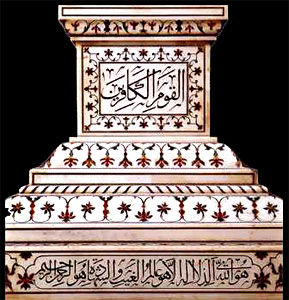 The calligraphic verses speak out loud the epitaph, "Arjumand Bano Begum, named Mumtaz Mahal died 36 years before the king`s death." On the top of Mumtaz Mahal`s tomb is a verse that tugs at the heart strings... "`He is everlasting. He is sufficient. God is ever at the side of the forsaken, the unfortunate and helpless, those for whom there is no God. He knows all that is not known and not seen. He showers his grace on all. He is compassionate". All around the cenotaph, on the sides the 99 names of Allah frame the spirit of the souls with a divine halo.
The calligraphic verses speak out loud the epitaph, "Arjumand Bano Begum, named Mumtaz Mahal died 36 years before the king`s death." On the top of Mumtaz Mahal`s tomb is a verse that tugs at the heart strings... "`He is everlasting. He is sufficient. God is ever at the side of the forsaken, the unfortunate and helpless, those for whom there is no God. He knows all that is not known and not seen. He showers his grace on all. He is compassionate". All around the cenotaph, on the sides the 99 names of Allah frame the spirit of the souls with a divine halo.
Just as their earthly life was lived together, so too was their journey into the world of spirit embarked resting, side by side. Emperor Shah Jahan`s cenotaph has a lovely inkwell adorning it. The idea behind its appearance is that in Islam it is believed that the husband could write his desires on a slate which his wife would fulfill in the life beyond. Therefore, Mumtaz Mahal`s cenotaph has a slate gracing the top. Rather remarkably, Shah Jahan`s cenotaph does not have verses from the Quran inscribed.
The sepulchres lie below in an airless crypt. They were once more heavily ornamented, sculpted and bejewelled than the cenotaph. However, some sections of the original ornamentation on the sepulchres were plundered. They have been artfully replaced by the regular quality material but the craftsmanship, in the discerning eyes of an expert, barely matches the original.
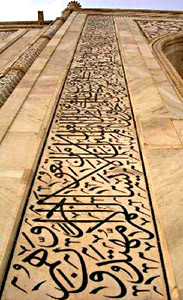 A maze of corridors and many basement chambers are present below. The entrances to the subterranean rooms are through two staircases on the northern side of the red sandstone plinth.
A maze of corridors and many basement chambers are present below. The entrances to the subterranean rooms are through two staircases on the northern side of the red sandstone plinth.
The temporary grave where Mumtaz Mahal was buried can be seen even today, a few meters to the southwest of the Taj Mahal. It rests solemnly near the western boundary wall where the well of the mosque is located. `Badshahnama`, the court journal of Shah Jahan, also records the burial of Mumtaz.
The mosque stands like a friendly pilgrim getting ready for a journey. Four octagonal towers and three elegant domes magnify its stately elegance. The sacred walls enclose 539 sparkling, velvet red, prayer carpet spaces in sandstone neatly outlined with black marble.
One stands magnetized by the ceiling`s hypnotic design. The walls beam out a chain of inscriptions from the Holy Quran that needs no language to be intuitively understood by the collective consciousness.
This great Mughal emperor celebrated his love for his Queen Mumtaz Mahal by building the world`s most beautiful monument of love. The Taj Mahal stands loftily as a surreal abode of love. Inspiring millions of visitors, the world over, feel the awesome energy of purity and perfection.
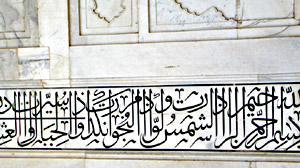 If a trick could be a feast, then the calligraphic verses would sure make a sumptuous celebration. Optical illusion is at its very best in Taj Mahal. The marvellous play with letters can only be experienced by standing in front of the inscriptions and moving forwards and backwards. Amazingly, the letters that loom so large above are all of uniform size. It is only the density that has made all the difference. At the bottom, the letters have been inscribed more densely. The gracefully curving lines of the Arabic script blend enchanting word pictures and holy names beautifully, within the marble blocks to form an exquisite tapestry of divine emotions.
If a trick could be a feast, then the calligraphic verses would sure make a sumptuous celebration. Optical illusion is at its very best in Taj Mahal. The marvellous play with letters can only be experienced by standing in front of the inscriptions and moving forwards and backwards. Amazingly, the letters that loom so large above are all of uniform size. It is only the density that has made all the difference. At the bottom, the letters have been inscribed more densely. The gracefully curving lines of the Arabic script blend enchanting word pictures and holy names beautifully, within the marble blocks to form an exquisite tapestry of divine emotions.
A full fourteen chapters of the Holy Quran are inscribed on the walls. Semi-octagonal plasters rising from the plinth of the tomb along with a chevron pattern inlaid with black and yellow marble horizontally give a fantastic fluted effect.
What really matters at the end of the day is that there still remains on the face of the earth this remarkably, beautiful, monument created by human hands to celebrate an emotion; an offering to the divine or perhaps a sacred reminder to preserve forever the power of a divine emotion, Love.
Main Gateway of Taj Mahal
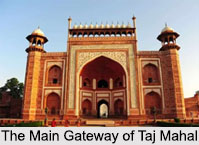 The main gateway of Taj Mahal or the Darwaza-i-Rauza was constructed between the years 1632-1638. The gate was designed by the architect named, Ustad Ahmad Lahauri, which was confirmed based on the writings of his son Lutfullah Munhadis.
The main gateway of Taj Mahal or the Darwaza-i-Rauza was constructed between the years 1632-1638. The gate was designed by the architect named, Ustad Ahmad Lahauri, which was confirmed based on the writings of his son Lutfullah Munhadis.
The main gateway of the Taj Mahal leads to the marble dome. This innocuous gate displays the carved Hindu motifs on them. According to Islam a gateway signifies passing from a materialistic world of senses into a divine world of spirit. The gateway is one of the five important elements of Taj Mahal, which was the main entrance during its construction. The double-storey main gateway of the Taj Mahal, 93 feet high and 150 feet wide, is built in red sandstone. The doorway is of ogival arch shape that reaches the gateway structure till the mid-height of it.
There are octagonal shaped towers at the corners of the main gateway, which are surrounded by open-doomed pavilion. Over the central portion of the gateway, there are 11 umbrella shaped marble cupolas. A big decorated arched chamber lies in the archway of the main gate. It has rooms with twists, branches and side branches to hallways. It was most probably built to confuse people from entering them. These rooms have not been used for about three centuries.
The Arabic calligraphy from the Holy Quran and motifs of entwined flowers, leaves and vines are spiraling down its niches. These motifs have been made by semi-precious stones inlaid in the white marble. As one enters the gateway, a lovely arch spreads out in the shape of double-storey wings. It seems as if someone is welcoming the visitors with their stretched arms. What further beautifies the gateway to the Taj Mahal is the image of a white teardrop with a red trident. The sculpture of the gateway reflects the Hindu style. In fact the red lotus here stands for the Hindu God Lord Brahma.
Sculpture of Taj Mahal
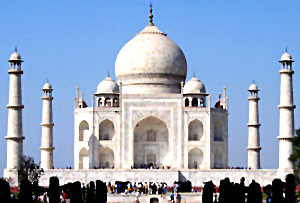 The sculpture of Taj Mahal is indeed awe-inspiring. When one is quite close to the monument the sculpture of Taj Mahal can be truly appreciated. The gigantic, sky-high dome towers upwards as if reaching out to celestial beings in a universe beyond. Though apparently delicate, the dome is quite rugged with a wall thickness of 14 feet and a circular spread that is nearly 4 times more. It further surrounded by 4 cupolas with an inner diameter of nearly 30 feet.
The sculpture of Taj Mahal is indeed awe-inspiring. When one is quite close to the monument the sculpture of Taj Mahal can be truly appreciated. The gigantic, sky-high dome towers upwards as if reaching out to celestial beings in a universe beyond. Though apparently delicate, the dome is quite rugged with a wall thickness of 14 feet and a circular spread that is nearly 4 times more. It further surrounded by 4 cupolas with an inner diameter of nearly 30 feet.
Domes have a very special significance in both Islamic and Hindu architecture. It is believed that the power and energy of a celestial presence can be felt by standing under the centre of the dome in silence. In the stillness clear answers to puzzled questions easily come. One can only gaze awestruck at the grandeur of the building that stands tall at 244 feet, taller than the Qutab Minar at Delhi. Most people think that the ground on which they are standing is the ground floor. In reality it is the fourth floor. The level of the courtyard corresponds to the third floor.
Quite remarkably, it is the four top stories that have the lovely marble plastering. The remaining three floors below are actually made of red sandstone. In fact, it is quite probable that the entire building was once made of red sandstone, before the marble replaced it as an afterthought. Two identical buildings stand on either side of the Taj Mahal like identical twins. The one to the west is a mosque while the other is a community hall.
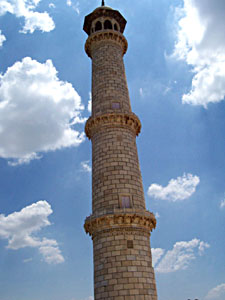 Sunlight plays hide and seek with invisible pillars of air. Golden rays of sunbeams dance through a million, secret stairways to emerge transformed as columns of vibrant energy. A rare harmony, of perfectly synchronized movements spells a mind-blowing fusion of shapes and styles. Each day, a dazzling display of light and shade alters contours and draws anew arches and pillars, fragrant flowers and sacred verses. Even as translucent shades of white reflect afresh their brilliance. They appear pure, pristine, yet broodingly melancholy in their awesome splendour.
Sunlight plays hide and seek with invisible pillars of air. Golden rays of sunbeams dance through a million, secret stairways to emerge transformed as columns of vibrant energy. A rare harmony, of perfectly synchronized movements spells a mind-blowing fusion of shapes and styles. Each day, a dazzling display of light and shade alters contours and draws anew arches and pillars, fragrant flowers and sacred verses. Even as translucent shades of white reflect afresh their brilliance. They appear pure, pristine, yet broodingly melancholy in their awesome splendour.
On some days at noon, the Taj Mahal sparkles with the brightness of a thousand suns, radiating a healing warmth that lights up the hearts of young and old, near and far. At night the sparkling radiance of a million stars cheers the mind. The beauty of Taj Mahal is mystical as it represents ageless wisdom and at other times the perfectly harmonious proportions of a beautiful building can astound the mind.
Tranquility steps in through delicate bouquets of floral sculpture and dedicated verses. Jewels are also part of the sculpture of Taj Mahal. These are found in a panoramic assortment of colours and shades and bring to life the beauty of flowers. No stone was left unturned, so to say as the rarest and most precious of gems and jewels from India and different parts of the world were used. Drawn by powerful teams of bullocks, horses, camels and elephants from all over India the gemstones came. Jasper from Punjab, diamonds from Patna, red stone from Fatehpur Sikri and garnets from Bundelkhand.
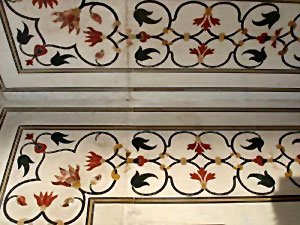 These jewels have been brought from far and distant lands. Crystal was brought from China, cornelian from Baghdad, turquoise from Tibet, agate from Yemen, sapphires and lapis lazuli from Ceylon, coral from Arabia and the Red Sea and onyx from Persia were just some of the huge assortment of gemstones used.
These jewels have been brought from far and distant lands. Crystal was brought from China, cornelian from Baghdad, turquoise from Tibet, agate from Yemen, sapphires and lapis lazuli from Ceylon, coral from Arabia and the Red Sea and onyx from Persia were just some of the huge assortment of gemstones used.
It is amazing to watch the different hues of the colour white in this monument. Its various hues are reflected in the walls, floors, corridors, dome and latticed framework of the Taj Mahal. It is not just the tones in white that radiate such an aura of peace. Black and yellow marble enliven the art to distinct patterns. The finest white marble from Makrana was used. Besides, white marble from Jaipur, yellow marble from the banks of the Narmada and black marble from Charkoh were all used. That marble could have such an infinite array of textures feels like an adventure into an ethereal universe. The smoothness of silk, the rugged strength of granite and the tenacity of steel are seen here. The sun and wind seem to breathe life into marble.
Joy and sorrow find solace in the many layers of stone. Marble in its many moods has never been so perfectly blended as to be an awesome expression of a surreal emotion. The indefatigable energy of a joyous spirit continually striving to persevere and perfect forever, the essence of a precious emotion haunts the marbled spaces. Like life experienced in manifold layers of complexities, the calligraphic verses too serve countless interpretations depending on the eye of the beholder. The sheets of marble appear to shoulder a grave responsibility, to serve as mystic problem solver to crowded flocks of humanity.
The walls and floors, arches and pillars in their brilliant, geometric designs, blend with one another to give one the experience of being a traveller to another world. Taj Mahal is truly a wonder. As the sun`s rays fall on the marble they emit the shades of grey, mauve, rose and russet and even some ravishing hues of gold and silver. The colours and tints keep changing with the seasons and the passing moments. When it came to building the main tomb, the architects decided on doing it freehand. The result is a fantastic optical illusion, not discernible even to the discriminating eye.
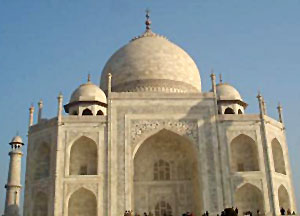 The central point on either side of the main tomb is almost half to one inch higher than the sides. The deliberate convexity given to the plinth in the centre of each arch will compel the onlooker to gaze at it in admiration and amazement. Without that special effort, the building would have looked as if it were falling down.
The central point on either side of the main tomb is almost half to one inch higher than the sides. The deliberate convexity given to the plinth in the centre of each arch will compel the onlooker to gaze at it in admiration and amazement. Without that special effort, the building would have looked as if it were falling down.
Another sculptural delight at Taj Mahal is the delicately reticulated frames. The extraordinary artistry of the sculptors in creating dainty filigree is bound to astonish the viewer. Octagonal lattice frames screen the tomb. They stand as mute defenses, as sacred, protective shields of awesome beauty.
As the placid drops of sunshine flow into the room in gentle swirls and eddies, they reflect the serene contemplation of pious minds and searching for a resting place. Double screens of white marble trellis work, exquisitely patterned from within and without, enchant the eyes as bejewelled wands of sunbeams filter through many apertures.
Moreover it is believed that the lattice screens, eight feet high, were carved from single blocks of marble, octagonal in shape over a period of ten years. Embroidered with the rarest of gems, flowers reach out gracefully to echo a fragrant essence. Lapis lazuli, coral, cornelian, jade, agate, bloodstone and other precious gems breathe life into lilies, irises and so many other beautiful flowers. The painstaking perfection with which each flower has been given the breath of reality is astounding.
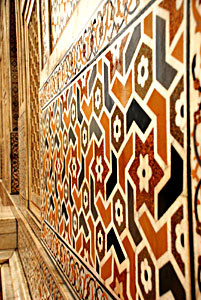 In some instances in order to get the correct shade, the sculptors used as many as 60 different gems in an area that was less than one square inch. Piedra dura or stone inlay work reached dazzling heights of perfection during the reign of the Mughal rulers. In addition to these the contoured arches, grooves and apertures have been perfectly carved.
In some instances in order to get the correct shade, the sculptors used as many as 60 different gems in an area that was less than one square inch. Piedra dura or stone inlay work reached dazzling heights of perfection during the reign of the Mughal rulers. In addition to these the contoured arches, grooves and apertures have been perfectly carved.
As one wanders about from frame to frame appreciating the sculpture of Taj Mahal, he or she will be further astonished by the mystical experience of octagonal rooms. These rooms reach out to the eight different directions. At the comer of each room spiral stairway helps lift one quite literally to a higher dimension.
Diametrically opposite the centre of the dome on the ground below are located the cenotaphs or false tombs and in the chambers below the sepulchers or the real tombs. A beautiful lamp that was made in Egypt sways to the lilting melodies of a celestial celebration. The lamp is a lovely addition made by Lord Curzon during his efforts at renovating and preserving the Taj Mahal. Originally, a chandelier of agate and another of silver was used.
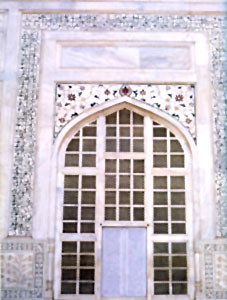 A graceful arch, a few feet higher than the lattice frames ushers one in to explore another dimension of life. Muted tones of words lost in deep reverie charge the floor`s repeating geometrical and floral patterns of black and white.
A graceful arch, a few feet higher than the lattice frames ushers one in to explore another dimension of life. Muted tones of words lost in deep reverie charge the floor`s repeating geometrical and floral patterns of black and white.
In its hushed silence, one may feel the presence of divine spirits holding out eclectic debates on the origins of creations. The echoing melodies of whispered hymns and sacred chants resonate in the air. Moreover the ghazals and `Shayarees`, melodious rhythms and magical ballads, bring to life the alluring beauty of an earlier time. Mystic symbols of grace touch the sacred cenotaphs and the sepulchres below with an eternal glow of life.
The sculpture of Taj Mahal is worth watching as it makes one realize that there still exists on earth a monument, the like of which one only reads about in mythological tales, from millennia ago, is unbelievable. Standing majestically against the backdrop of a great river, the monument invites one to join in a cosmic celebration.
The sculpture of Taj Mahal gets a completely new dimension as one watches the monument and the Jamuna River together. The static monument stands as a declaration of love as the river meanders gracefully in the background. Jamuna sometimes seems as a wavy, blue, green ringlet swirling with the breeze. At other times, the river moves fast, like a star, spangled blue- grey shimmering sheet of water drawing one in, like quick sand. While standing before the Taj Mahal, the viewer will definitely be transported to another world.
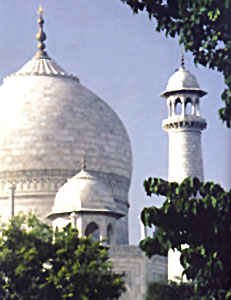 If distance makes the heart grow fonder, then even from a great distance the beautiful sculpture of Taj Mahal draws the heart-strings closer with each passing step. The entire space around the complex was once Mumtazabad. It was home to thousands of craftsmen working on this great project.
If distance makes the heart grow fonder, then even from a great distance the beautiful sculpture of Taj Mahal draws the heart-strings closer with each passing step. The entire space around the complex was once Mumtazabad. It was home to thousands of craftsmen working on this great project.
An innocuous gate marks the entry into the complex. Before one reaches this gate, two octagonal buildings greet the eye. On the left is the tomb of the Serving Ladies, while on the right is the Fatehpuri Mosque, also known as the Stonecutter`s Mosque. In Islam the gateway to a tomb is of great significance. It means passing from a materialistic, physical world of senses, into a divine world of spirit.
Within the gateway is an arterial corridor that threads into different rooms leaving the visitor disoriented, should one decide to enter. With its many rooms, the gateway forms a stupefying maze of perplexing spaces. At a height of 100 feet and in red sandstone, the four-storied gateway looms tall even in front of the Taj Mahal.
A lovely arch spreads out to form double-storey wings. The wall of the arch folds inwards to form a chamber within the roof. Octagonal towers at the corners with attractive, open domed kiosks draw one`s attention. The eleven chhatri`s (umbrellas) with marble cupolas on the north and south sides appear to be singing out a warm greeting.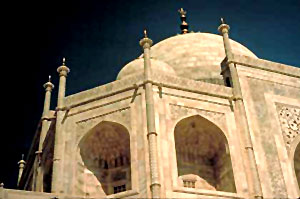 Midway between the gateway and the Taj Mahal on either side of the courtyard are two identical buildings known as the `Nagar-Khanas` or drum houses.
Midway between the gateway and the Taj Mahal on either side of the courtyard are two identical buildings known as the `Nagar-Khanas` or drum houses.
It is amazing, but as one stands in front of the towering gateway, the enchanting tomb looks much smaller than one imagined it to be. One wonders about the photographic tricks that have gone into all those famous pictures of hundreds of people looking so tiny in front of the Taj Mahal. Then again, as one nears the edifice, the flashback of mere pictures pales into insignificance as a synthetic image simply cannot emulate the magical spell of the real thing.
Monuments in Taj Mahal
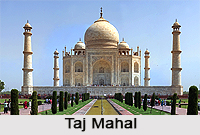 There are several monuments in Taj Mahal that add to the beauty of the marble dome. Built by Mughal emperor Shah Jahan, Taj Mahal stands as the testimony of love between the emperor and his beloved wife, Mumtaz Mahal. Apart from the main building there are several units within this monument that are worth checking out.
There are several monuments in Taj Mahal that add to the beauty of the marble dome. Built by Mughal emperor Shah Jahan, Taj Mahal stands as the testimony of love between the emperor and his beloved wife, Mumtaz Mahal. Apart from the main building there are several units within this monument that are worth checking out.
These are:
• Darwaza or the Main Gateway
• Bageecha or the Gardens in Taj Mahal
• Masjid or the Mosque
• Naqqar Khana or the Rest House
• Rauza or the Main Mausoleum
The main gateway of the Taj Mahal has been adorned with Hindu motifs. In fact the Hindu style of architecture is quite dominant as far this unit of the Taj Mahal is concerned. Shah Jahan has always led a lavish life. This gateway is the stepping stone to the opulence of the Mughal emperor. Beyond the `darwaza` stands one of the world`s Seven Wonders of the World, a saga of love etched out in marble.
Within the premises of Taj Mahal lies the mosque or the `masjid.` Built in red sandstone the mosque faces the direction of Mecca, the holy city for the Muslims. It is still used for offering prayers. The sculpture of the mosque is as interesting as the rest of the monument. It is built with Pietra Dura and there are 4 octagonal towers and 3 domes. Inside the mosque the floor is spanking clean. It reflects a velvet red shade and is further covered with as many as 539 carpets. These are the prayer carpets. The calligraphy within the mosque display quotations from the Quran.
Opposite to the mosque stands the Naqqar Khana or the Rest house. This unit has also been built in red sandstone. This building is faced away from the direction of the Mecca. Another unit of the Taj Mahal that adds to the charm of the monument is the garden. Sprawling and well maintained the garden in Taj Mahal mainly comprises Cyprus and other fruit beating trees. Coincidentally these trees signify death. Four is considered to be a holy number in Islam. Hence the flower arrangements in the Taj Garden or the Char Bagh are made in four or its multiples. 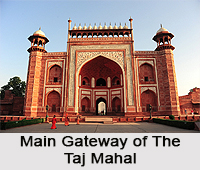
Last but not the least Taj Mahal comprises the main mausoleum or the Rauza. It stands at a height of 200 feet. The mausoleum is situated opposite the Taj garden as the River Jamuna meanders in the background. The sculpture of Taj Mahal is exquisite to say the least. A marble podium has been built and above it one will come across the four minarets placed at the four corners of the podium. These minarets are almost 138 ft high. The interior of the Taj Mahal have been adorned with outstanding calligraphy, frescos, arched gateways and an amalgamation of Persian and Hindu art.
The artistic wizardry of these monuments in Taj Mahal definitely makes the monument in Agra worth a visit.
Garden in Taj Mahal
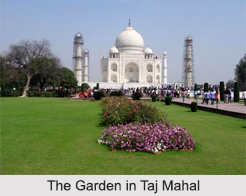 The Taj Mahal garden is also known as the "Charbagh" garden. It not only adds the splendour to the Taj Mahal, but also gives it serene and tranquil ambience which makes the Taj Mahal an existent delight. Taj Mahal is endearing and special as a love story or ode to love ever created by human. From the moment it is sighted, it grabs a tiny, corner space in the head to remain a part of one for evermore, a shadow figure that travels everywhere. Ever once in a while this etched monument acquires larger than life proportions in one`s head to reaffirm an imposing presence - like a magician`s bewitching trick.
The Taj Mahal garden is also known as the "Charbagh" garden. It not only adds the splendour to the Taj Mahal, but also gives it serene and tranquil ambience which makes the Taj Mahal an existent delight. Taj Mahal is endearing and special as a love story or ode to love ever created by human. From the moment it is sighted, it grabs a tiny, corner space in the head to remain a part of one for evermore, a shadow figure that travels everywhere. Ever once in a while this etched monument acquires larger than life proportions in one`s head to reaffirm an imposing presence - like a magician`s bewitching trick.
Arrangements of the Garden in Taj Mahal
The technique of the garden in Taj Mahal comes from the Persian Timurid technique of gardens and is based on the notion of paradise garden which was brought into by Babur. The gardens of the Taj Mahal has trailed the tradition of number four and its multiples. Number four or its multiples are considered as the holiest number of Islam religion so the "Charbagh" Garden of Taj Mahal was made all the actions consequently.
The Garden in Taj Mahal is arranged in a symmetrical outline, the trees of the Taj garden are planted of Cyprus which is signifying death or of the fruit bearing type which is signifying the life. This garden is packed with flowers, fruits, birds, leaves, symmetry, and delicacy, which served a lot of functions along with depicting abstract meanings about paradise. Out of the total area of 580 meter by 300 meter of the Taj complex, these gardens cover an area of 300 meter by 300 meter distance. These are based on geometric arrangements of natural world.
The whole garden is divided into four parts, with two marble canals filled with fountains crossing in the centre. In every area, there are 16 plots which have been divided by stone-paved raised lanes. It is believed that even each of the plots was planted with 400 plants. Between the Taj Mahal, there is an elevated marble lotus-tank with a border, at the centre of the garden. It reproduces the shadow of Taj Mahal in water. The four waterways distinguished into the balance has been organized.
Visiting Information of Taj Mahal
The Taj Mahal is closed on Fridays and the nearest train station to Taj is named Agra Fort Railway Station, 3 kilometres from Taj Mahal. Agra"s Kheria airport is a military base and the flight from Delhi to Agra is less than an hour long. Kheria airport is 13 kilometres away from Agra city. Agra is well connected by bus to cities and the daily buses ply.



















